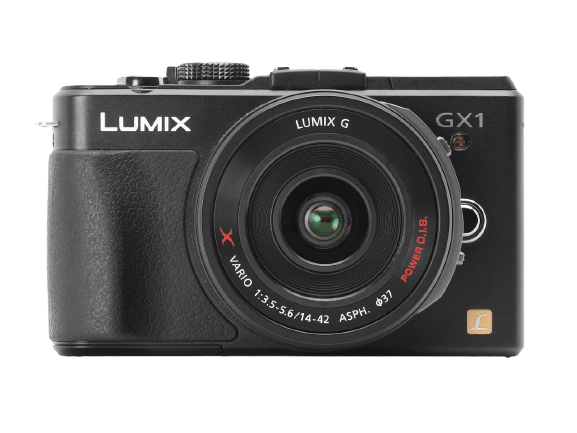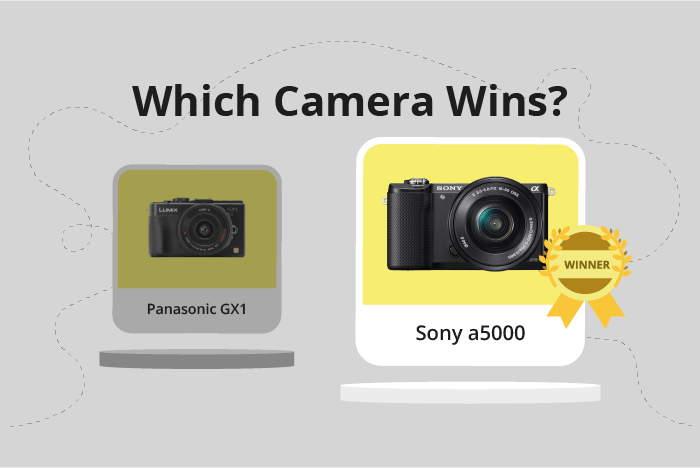Panasonic Lumix DMC GX1 vs Sony a5000 Comparison
Panasonic Lumix DMC GX1

Sony a5000

The Sony a5000 emerges as the winner with a score of 51/100, while the Panasonic Lumix DMC GX1 trails behind with 43/100. Both cameras are mirrorless and were released within a few years of each other, with the GX1 in 2011 and the a5000 in 2014. They share similarities in size, but the a5000 is slightly smaller and lighter, measuring 110 x 63 x 36mm and weighing 269g.
The Sony a5000 outperforms the GX1 with a lower launch price of $500 compared to the GX1’s $699. This makes the a5000 a more affordable option. On the other hand, the GX1 does not have any significant advantages over the a5000.
Taking these factors into account, the Sony a5000 is the better choice due to its higher score, lower price, and compact design.
Panasonic Lumix DMC GX1 vs Sony a5000 Overview and Optics
The Sony a5000 outperforms the Panasonic Lumix DMC GX1 in optics with a score of 60/100 compared to the GX1’s 42/100. Both cameras share some common specifications, such as having a CMOS sensor, no image stabilization, and a similar lens mount system (Micro 4/3 for the GX1 and Sony E for the a5000).
The Sony a5000 surpasses the GX1 in several aspects. It has a higher resolution with 20 megapixels compared to the GX1’s 16 megapixels, resulting in more detailed images. The a5000 also features a more advanced processor, the Bionz X, which contributes to better image processing and overall performance. Moreover, the Sony a5000 has a higher DXOMARK score for the sensor, 79, while the GX1 only scores 55, indicating better image quality. Additionally, the a5000 has a larger sensor size, APS-C, compared to the GX1’s Micro Four Thirds sensor, allowing for improved low-light performance and a shallower depth of field.
On the other hand, the Panasonic Lumix DMC GX1 offers a faster shooting speed of 4.2 frames per second, compared to the a5000’s 3.5 frames per second. This advantage allows the GX1 to capture fast-moving subjects more effectively.
Taking these points into consideration, the Sony a5000 is the superior option in terms of optics, with a higher resolution, better image quality, and a larger sensor size. The Panasonic Lumix DMC GX1, however, can still be a viable choice for those who prioritize shooting speed for action photography.
Panasonic Lumix DMC GX1 vs Sony a5000 Video Performance
The Sony a5000 emerges as the winner in the video capabilities comparison, scoring 70/100, while the Panasonic Lumix DMC GX1 trails behind with a score of 43/100. The 27-point difference highlights the superior performance of the Sony a5000.
Both cameras share some common video specifications, such as Full HD video resolution and maximum video dimensions of 1920 x 1080. However, the Sony a5000 outshines the Panasonic Lumix DMC GX1 in terms of its maximum video frame rate and time-lapse functionality. The Sony a5000 boasts a higher maximum video frame rate of 60fps, compared to the Panasonic Lumix DMC GX1’s 30fps. This allows the Sony a5000 to produce smoother and more professional-looking videos. Additionally, the Sony a5000 has built-in time-lapse functionality, which the Panasonic Lumix DMC GX1 lacks. Time-lapse functionality enables users to create stunning and creative videos, making the Sony a5000 a more versatile option for video enthusiasts.
On the other hand, the Panasonic Lumix DMC GX1 does not offer any significant advantages over the Sony a5000 in terms of video capabilities. Its lower video score and lack of time-lapse functionality make it a less desirable option for those seeking advanced video features.
Taking these points into consideration, it is clear that the Sony a5000 is the better camera for video capabilities. Its higher maximum video frame rate and built-in time-lapse functionality provide users with more creative options, while the Panasonic Lumix DMC GX1 falls short in these areas. The 27-point difference in their scores signifies the superiority of the Sony a5000 in the realm of video performance.
Panasonic Lumix DMC GX1 vs Sony a5000 Features and Benefits
The Panasonic Lumix DMC GX1 wins in the features comparison with a score of 49/100, while the Sony a5000 scores 37/100. Both cameras share some specifications, like having a 3-inch screen size and no GPS or Bluetooth capabilities. However, there are some differences that make one camera better than the other in certain aspects.
The Lumix GX1 has a touchscreen, which the Sony a5000 lacks. This feature makes it easier for users to navigate menus and adjust settings quickly. Additionally, the GX1’s screen resolution is slightly lower at 460,000 dots compared to the a5000’s 460,800 dots, but this difference is negligible and does not significantly impact the user experience.
On the other hand, the Sony a5000 has a flip screen, which is not present in the Lumix GX1. This feature allows users to take selfies or record videos from different angles more conveniently. Furthermore, the a5000 has built-in WiFi, enabling users to transfer photos and videos to other devices without the need for cables or card readers.
While the Panasonic Lumix DMC GX1 has a higher feature score and a touchscreen, the Sony a5000 offers a flip screen and WiFi capabilities. These differences highlight the unique strengths of each camera, catering to different user preferences. Ultimately, the choice between these two cameras depends on the user’s priorities and which features they value the most.
Panasonic Lumix DMC GX1 vs Sony a5000 Storage and Battery
The Sony a5000 outperforms the Panasonic Lumix DMC GX1 in storage and battery with a score of 24/100 compared to 21/100. Both cameras have one memory card slot and accept SD, SDHC, and SDXC cards. However, the Sony a5000 also accepts Memory Stick Pro Duo cards, giving it an advantage in storage options.
The battery life of the Sony a5000 is another winning factor, providing 420 shots compared to the Panasonic GX1’s 310 shots. Both cameras use different battery types, with the a5000 using the NP-FW50 and the GX1 using the DMW-BLD10. Neither camera offers USB charging capabilities.
While the Panasonic GX1 loses in this comparison, it still provides sufficient storage and battery life for casual photography. The Sony a5000, with its longer battery life and additional memory card compatibility, is the better choice for those prioritizing storage and battery performance.
Panasonic Lumix DMC GX1 vs Sony a5000 – Our Verdict
Are you still undecided about which camera is right for you? Have a look at these popular comparisons that feature the Panasonic Lumix DMC GX1 or the Sony a5000:

